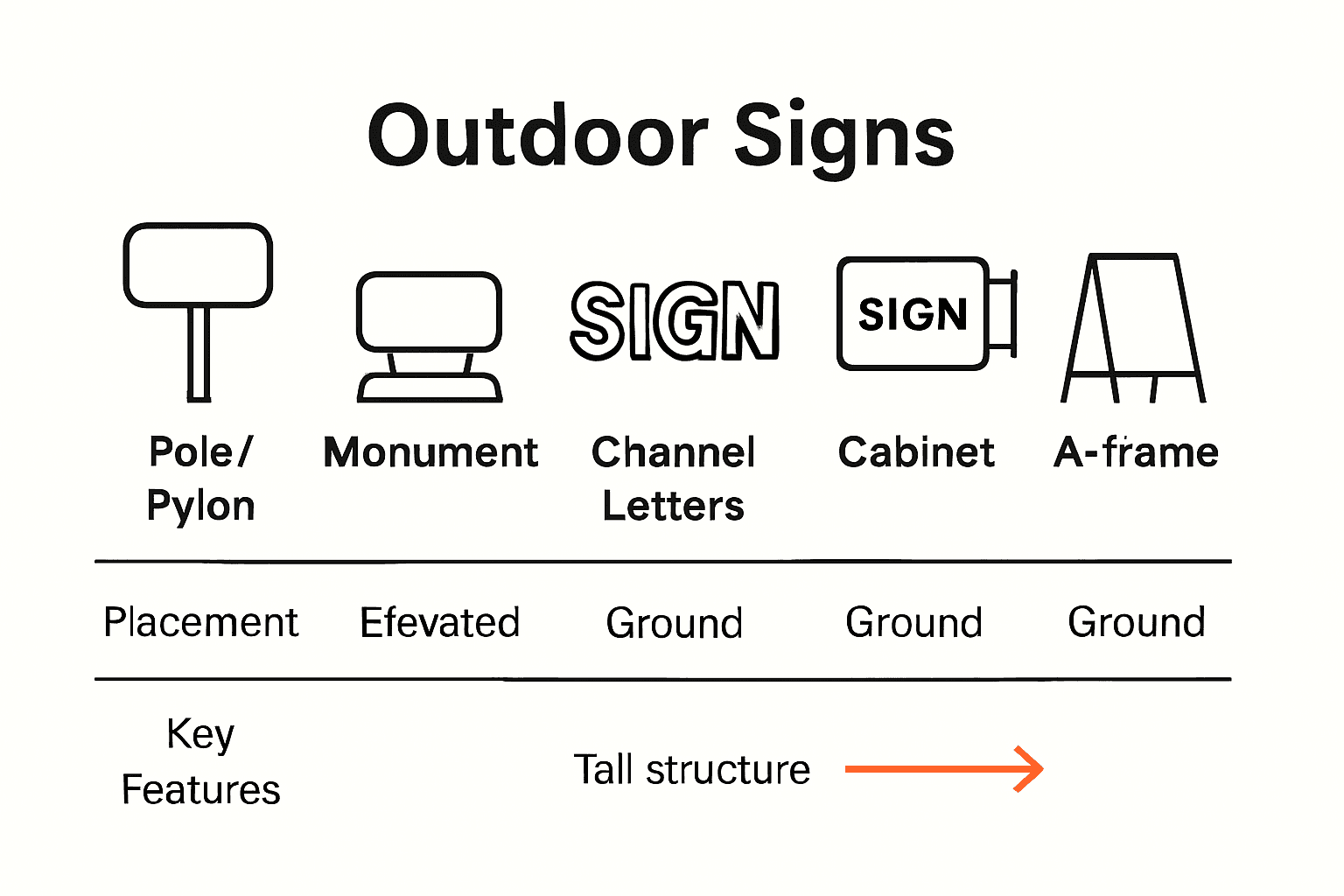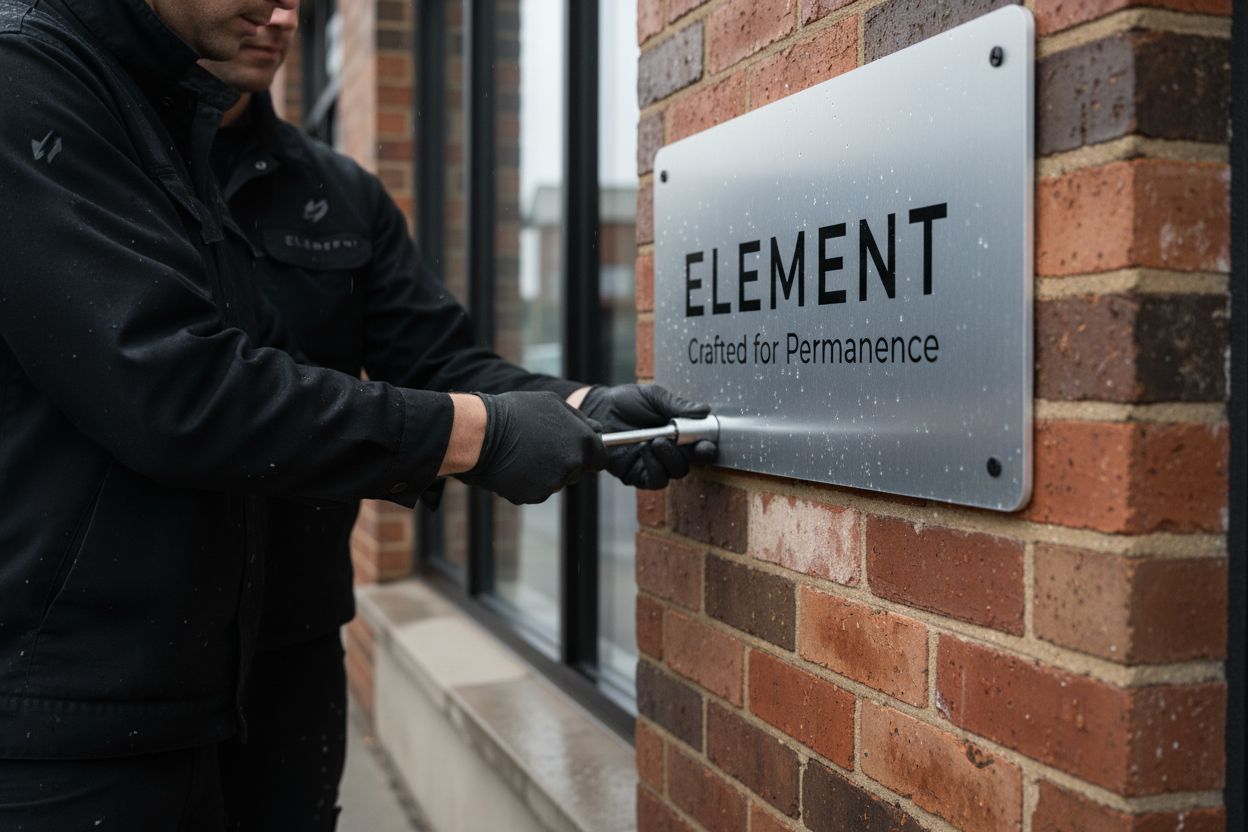Did you know that quality exterior signage can increase a business’s revenue by up to 7 percent? Outdoor signs do much more than show a name or logo. They shape first impressions, guide visitors, and help customers remember where you are. The right design and material choices can make your business stand out in crowded spaces while supporting accessibility and compliance requirements.
Key Takeaways
| Point | Details |
|---|---|
| Exterior Signage as a Brand Extension | Effective exterior signage reflects a brand’s visual identity and serves as a vital communication tool with potential customers. |
| Design Principles Matter | High contrast, simplicity, and appropriate spacing are crucial design elements for ensuring visibility and brand recognition. |
| Material Selection is Key | Choosing durable materials like aluminum can enhance the longevity and appearance of signage in varying environmental conditions. |
| Compliance and Planning are Essential | Adhering to local regulations and proper installation practices is vital to avoid costly fines and ensure optimal sign performance. |
Table of Contents
- Defining Exterior Signage And Its Purposes
- Popular Types Of Outdoor Signs Explained
- Material Options And Durability Factors
- Design Principles For Effective Outdoor Signage
- Installation, Permitting, And Compliance Essentials
- Common Mistakes In Outdoor Signage Selection
Defining Exterior Signage and Its Purposes
Exterior signage is more than just a visual marker – it’s a powerful communication tool that connects businesses with their audience. Wayfinding signage serves as a critical navigational element, guiding people through physical environments with strategic visual cues. According to Wikipedia’s research on wayfinding, these signs play an essential role in establishing place identity and supporting accessibility standards under the Americans with Disabilities Act.
At its core, exterior signage functions as a physical extension of a brand’s visual identity. The effectiveness of these signs depends on several key design principles:
- High contrast visual elements
- Appropriate spacing between text and graphics
- Simplicity in design approach
As insights from Zigo Sign indicate, unified visual branding can dramatically increase visibility and recognition. These signs aren’t just informational – they’re strategic marketing assets that communicate your brand’s personality, professionalism, and purpose.
Beyond aesthetics and navigation, exterior signage serves multiple critical purposes for businesses. They provide essential information, create first impressions, enhance location visibility, and help potential customers find and remember your space. Read more about our exterior sign solutions to understand how the right signage can transform your business’s external communication strategy.
Popular Types of Outdoor Signs Explained
Outdoor signage is a diverse landscape with multiple styles designed to capture attention and communicate brand messaging. According to Safety Decals, businesses have several primary sign types to choose from, each serving unique visibility and placement requirements.
Key Outdoor Sign Varieties
Pole/Pylon Signs stand tall and are perfect for locations with high-traffic visibility, often used near highways or large parking areas. Monument Signs offer a more grounded, elegant approach, typically placed near building entrances or property boundaries. These ground-level signs provide a sophisticated first impression.
Channel Letters represent another popular outdoor sign option. Wikipedia research describes these as three-dimensional metal or plastic letters, frequently internally illuminated for maximum visual impact. These signs deliver exceptional visibility:
- Highly visible during day and night
- Customizable in size and color
- Professionally enhance building exteriors
Additional outdoor sign types include cabinet signs, which are boxed displays commonly seen on commercial buildings, and A-frame/sandwich board signs that offer flexible, movable advertising for street-level businesses. Explore our comprehensive outdoor signage solutions to find the perfect match for your specific business needs.
Here’s a summary of popular outdoor sign types and their primary features:

| Sign Type | Typical Placement | Key Features |
|---|---|---|
| Pole/Pylon | Highways Parking lots |
Tall Maximum visibility |
| Monument | Building entrances Property edge |
Ground-level Elegant look |
| Channel Letters | Building exteriors | 3D letters Illuminated |
| Cabinet | Commercial buildings | Boxed display Custom graphics |
| A-frame/Sandwich Board | Street-level sidewalks | Portable Changeable messages |
Material Options and Durability Factors
Selecting the right material for exterior signage is crucial for ensuring long-lasting performance and maintaining a professional appearance. Impact Signs highlights a range of materials that offer unique combinations of durability, aesthetics, and functionality.
Metal Material Advantages
Aluminum stands out as a premier choice for outdoor signage, delivering exceptional benefits:
- Lightweight and rust-proof
- Excellent weather resistance
- Cost-effective long-term solution
- Easy to customize and fabricate

Beyond aluminum, other metal options like stainless steel and bronze provide premium alternatives with distinct visual characteristics. According to Safety Decals, the material spectrum for outdoor signs extends far beyond metals, encompassing:
- Plastics and Composites: Acrylic, PVC, Dibond, HDU
- Reflective Materials: High-visibility sheeting
- Specialty Options: Wood and faux-wood finishes
Each material brings unique performance characteristics, allowing businesses to select the perfect match for their specific environmental conditions and branding requirements. Discover our expert material recommendations to make an informed decision about your exterior signage investment.
Design Principles for Effective Outdoor Signage
Creating impactful exterior signage requires a strategic approach that balances visual appeal with clear communication. According to Zigo Sign, successful sign design hinges on several critical principles that ensure maximum visibility and brand recognition.
Key Design Strategies
Messaging Clarity is paramount. The research recommends limiting text to seven words or fewer, ensuring quick comprehension for viewers in motion. Visual design should incorporate:
- High-contrast color schemes
- 30-50% negative space
- Bold sans-serif fonts
- Strategically sized logos
As The Handh Group emphasizes, effective signage goes beyond mere aesthetics. It demands a holistic approach that considers:
- Legibility from various distances
- Minimal visual clutter
- Balanced text-to-graphic ratios
- Alignment with brand identity
Your sign’s design should communicate your brand’s personality while remaining functional and easily understood. Explore our directional signage solutions to see these principles in action and understand how professional design can transform your visual communication strategy.
Installation, Permitting, and Compliance Essentials
Successful exterior signage goes far beyond design – it requires meticulous planning and strict adherence to local regulations. East West Sign Group highlights several critical considerations that can make or break your signage project.
Navigating Regulatory Landscape
Permitting is the critical first step in any exterior sign project. Common installation pitfalls include:
- Ignoring local zoning regulations
- Selecting poor installation locations
- Using substandard materials
- Neglecting maintenance planning
According to House of Signs, compliance involves carefully evaluating multiple factors:
- Precise sign placement
- Appropriate sizing
- Lighting restrictions
- Traffic and visibility considerations
- Seasonal environmental impacts
These seemingly technical details can result in significant consequences – improper installation might lead to costly fines, mandatory sign removal, or repeated permitting expenses. Professional consultation becomes crucial in navigating these complex requirements. Learn more about our comprehensive sign permitting services to ensure your exterior signage meets all local regulations while maximizing visual impact.
Common Mistakes in Outdoor Signage Selection
Choosing the right exterior signage isn’t just about aesthetics – it’s a strategic decision that can significantly impact your business’s visibility and brand perception. Suttle-Straus highlights critical errors that can undermine your signage investment.
Design and Material Pitfalls
Environmental Resilience is often overlooked. Key mistakes businesses make include:
- Using non-UV-resistant inks that quickly fade
- Creating poor contrast designs
- Neglecting wind and temperature impacts
- Ignoring material security considerations
According to Sign Dealz, design complexity can also derail your signage effectiveness. Common design errors encompass:
- Overcomplicated visual layouts
- Selecting illegible font styles
- Inconsistent brand representation
- Choosing materials inappropriate for local climate
- Disregarding visibility requirements
These seemingly minor oversights can dramatically reduce your sign’s effectiveness and longevity. Explore our expert guidance on monument signs to ensure your exterior signage delivers maximum impact while avoiding these common pitfalls.
Elevate Your Business With Smart Exterior Signage Solutions
Are you struggling to make your brand stand out or help customers find your location easily? The article highlighted how crucial design, material quality, and compliance are to successful exterior signage. Many businesses underestimate the impact of first impressions, material durability, or even simple compliance, which can lead to lost foot traffic and unnecessary extra expenses. Ensuring your signage is both visually compelling and regulatory-friendly is an essential step many overlook. If you want to avoid common pitfalls and create signage that reflects your professionalism and draws attention, our comprehensive solutions can help.

Take the next step toward transforming your business visibility. Visit our main site to discover an extensive range of sign types, materials, and custom options designed for your brand’s needs. If you feel overwhelmed by choices or unsure where to start, explore our Uncategorized section for inspiration or guidance. Your next eye-catching, durable, and compliant sign is one click away. Secure your spot as a local standout and request your free quote today.
Frequently Asked Questions
What is exterior signage and its main purpose?
Exterior signage is a type of visual communication tool that helps businesses convey information, enhance brand visibility, and guide visitors through physical environments. Its main purpose includes providing important information, creating first impressions, improving location visibility, and assisting customers in navigating to and within a business.
What are the different types of outdoor signs?
There are various types of outdoor signs, including:
- Pole/Pylon Signs: Tall signs ideal for high-traffic areas.
- Monument Signs: Ground-level signs that offer an elegant touch.
- Channel Letters: Three-dimensional letters that are often illuminated.
- Cabinet Signs: Boxed displays commonly found on commercial buildings.
- A-frame/Sandwich Board Signs: Portable signs used for flexible advertising.
What materials are commonly used for outdoor signage?
Common materials for outdoor signage include:
- Aluminum: Lightweight and rust-proof, ideal for durability.
- Stainless Steel: Offers a premium look with great resilience.
- Plastics and Composites: Materials like acrylic and PVC are popular for various applications.
- Reflective Materials: Enhance visibility in low-light conditions.
Each material has unique characteristics that can be suited to specific environmental conditions and branding needs.
What are the key design principles for effective exterior signage?
Effective exterior signage should adhere to several design principles:
- Ensure messaging clarity by using limited text (ideally seven words or fewer).
- Use high-contrast color schemes and maintain 30-50% negative space.
- Choose bold sans-serif fonts for better legibility.
- Align designs with your overall brand identity. These principles ensure that signage is both visually appealing and easy to understand from various distances.

